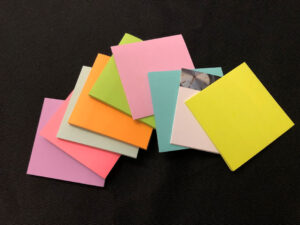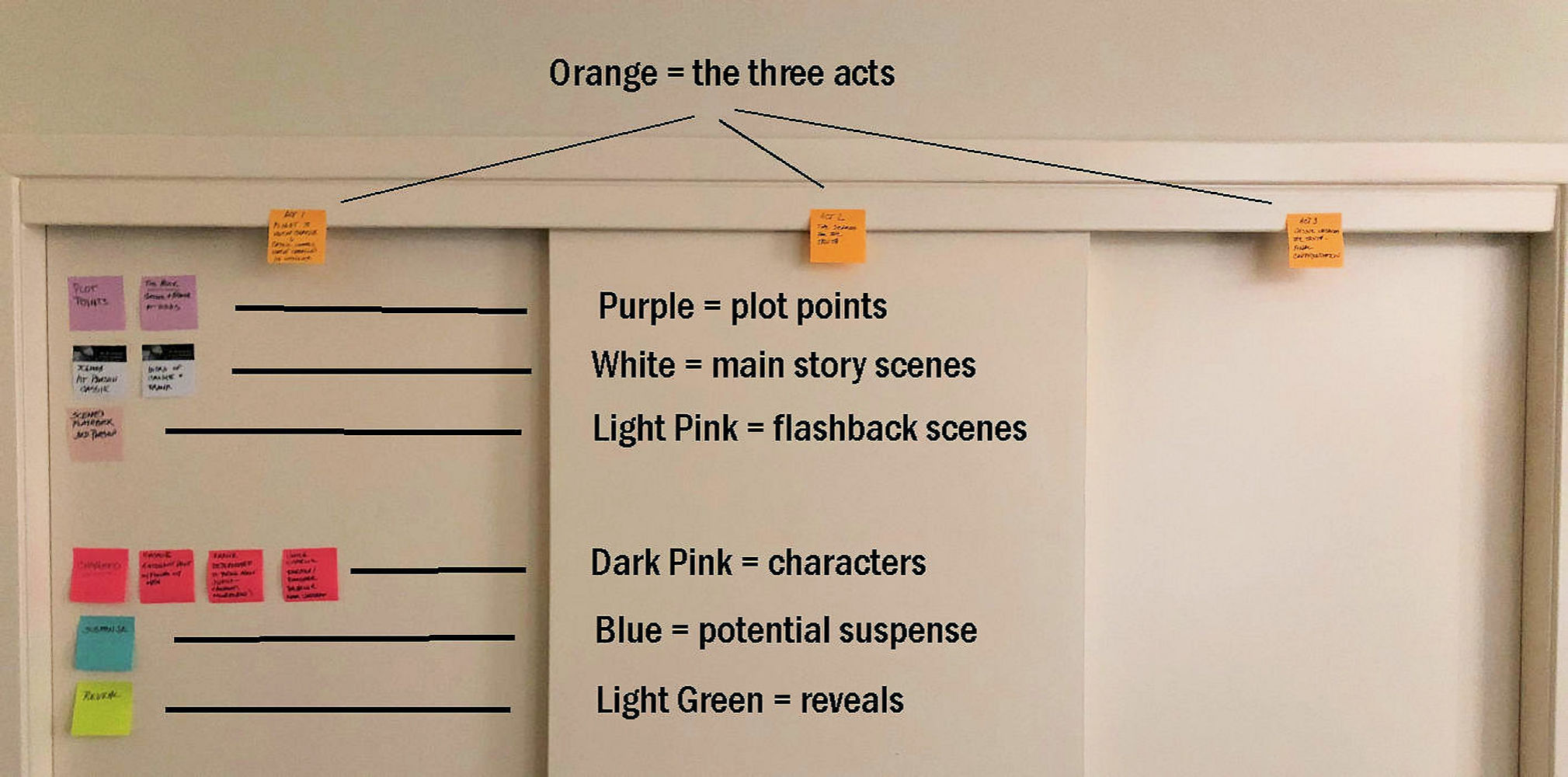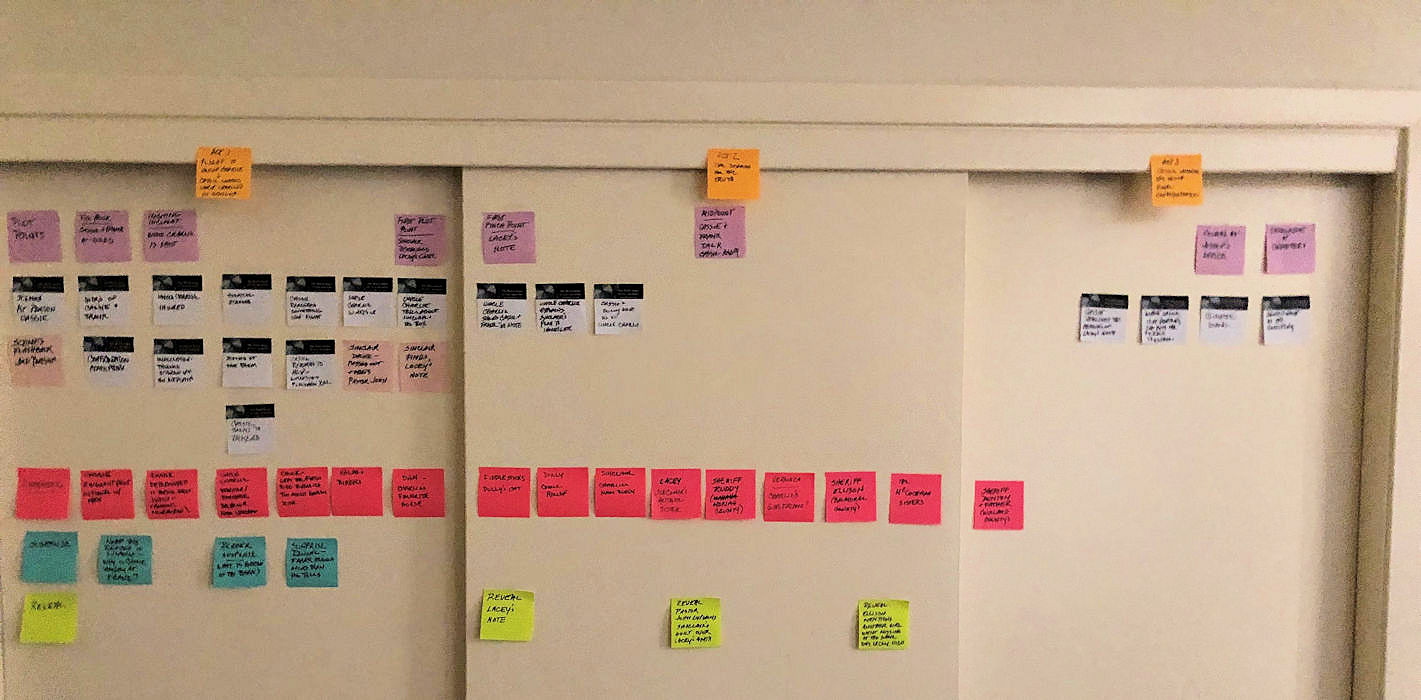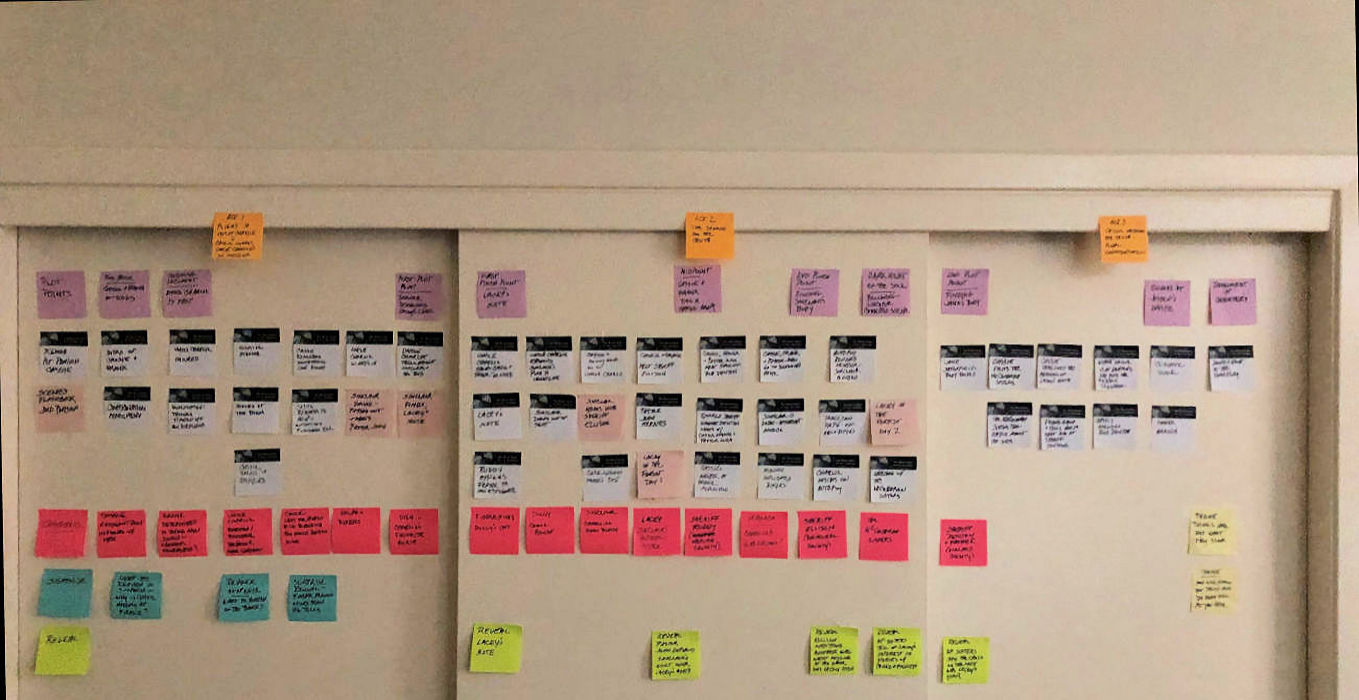
There’s a three-door closet in my office. At some point early in my writing career, it occurred to me that this closet would be particularly useful for creating a storyboard as I constructed my novels. Each door represented one act in the story.
I’m a hybrid plotter/pantser. I think of my method more as a process of iterative writing, and the storyboard works well for me. First, I come up with a general plot idea, post the first scenes on the storyboard, and start writing. Each day, I stand in front of the storyboard and think about how the story is developing. I decide on additional scenes, post them, write them, and repeat the process.
Here’s a brief summary of the post-it note storyboard I created for my fourth novel.
* * *
STARTING OUT
Once I decided on the first scene and a few characters, I set the storyboard up.. It was laid out horizontally, left to right. I use different colors to represent different elements of the story. Here’s a reconstruction of the initial setup for my WIP with definitions added for each color.

The three acts are in orange. The purple notes are plot points (e.g., hook, inciting incident.) The story is mainly written in first person, so the white notes are for those scenes. There are a few flashback scenes that are denoted by light pink. There has to be a fair amount of real estate for the white and light pink notes since scenes are the greatest part of the.storyboard.
Characters are in dark pink.
With this book, I had the idea to note particular places where I wanted the reader to wonder what’s going on (e.g., Why is she so mad? Why would thieves steal something of so little value?) I call those Suspense points, and they’re in blue.
I also wanted to mark where information is revealed to the reader. (e.g., Ah, that’s why he’s so distant.) Those Reveal notes are light green.
* * *
MAKING PROGRESS
I add or change the plot to satisfy something I’ve discovered, then I continue to write. Sometimes I decide on an ending before I’ve figured out all the details in Act 2. In the picture below, I’ve defined all the characters and have Act 1 pretty much under control. I’ve added scenes for Act 3, and I’ve begun work on the middle. Most of the purple plot points have been put in place.

This cycle continues until I think the story is completely fleshed out.
* * *
COMPLETING THE FIRST DRAFT
Here’s the storyboard as it appeared when I was close to completing the first draft.

You can see I added a couple of yellow post-it notes to the right-hand door. These are possible themes for the book.
At this point, the story is well-defined in my head, and I won’t bother changing the notes on the doors.
* * *
WHY DO I DO THIS?
There are several reasons I like the storyboard.
- I like seeing the entire story laid out in front of me as I’m building it. I can reacquaint myself with the sequence of events in just a few minutes.
- It helps me spot places where a new scene should be inserted or others should be rearranged.
- Moving things around is fast and easy.
- There’s something satisfying about the tactile nature of jotting down a note and adding it to the story or moving a note from one place to another.
- i can design my storyboard the way I want it without having to adapt it to an app.
There are ways to do this electronically. I work in Scrivener, and there’s a corkboard feature that displays scenes on an electronic corkboard. I suspect there are apps that let you lay out the entire story as I did here, but I can’t see the “big picture” without having a big space to lay it out on.
So TKZers: How do you plot your stories? Are you a plotter or pantser? Do you use an outline or some kind of index card layout to organize your thoughts?

This method appeals to my sense of organization and order in a chaotic world.
Alas, the other side of my brain dominates the writing process.
The chaos side.
Good morning, Laura!
I know what you mean. On the one hand, I need organization, but I also need to let the right side of my brain take the lead when I begin to write. This sometimes causes “after the fact” changes to the storyboard. (It helps to have a large inventory of post-it notes!)
Have a good week.
I plot with Dramatica, a screenwriting tool, and do my writing in Scrivener.
I’m a logical extreme plotter who likes to decide where everything in a story goes – character, plot points, and themes, before I get started, and then, when I get to the next scene with all its requirements and inclusions, I let the intuitive side of my brain loose to do the writing and deal with language.
Both Scrivener and Dramatica have ways to do structure like yours, even using colors.
Something about going to work as the pov character for the scene, figuring out how to make all those preassigned points work within the scene, suits me. Occasionally I’ll move one of the points to a different scene, but usually I’ve thought enough about the story that I can trust my planning – and write the scene as a short story in the chain from beginning to end.
It doesn’t get boring because there’s SO much going on, and I know, from writing a ragged and private rough draft, that the story goes where I want it to, so I can let the fun part happen – and write it down.
When I get stuck, I go visual with Scrivener’s cork board, the colors assigned to the three main characters, and a more detailed plan for the next chunk of scenes – one small detail at a time I CAN do, and it gets me back on track. So far, so good.
Good morning, Alicia!
It sounds like you’ve found the method that works best for you. I admire your ability to outline the story completely before you start writing.
I’m very analytical by nature, so when I started writing, I thought I would be a plotter. I was surprised when my brain took me in new directions as I was writing.
Have a great week.
Kay, thanks for sharing your visual process. Seeing the story spread out across three doors is a really helpful. I’m envious of your logical organization b/c I’m such a pantser. I took a couple of classes in Scrivener but could never get the hang of it.
In some of my earlier novels, I used different colored index cards spread all over the living room floor. Seeing the colors helped pinpoint where there were big lumps of backstory or too much time spent with one character, etc. But sometimes the dog rearranged scenes for me so the floor wasn’t a great option.
I need to remodel the house to include three doors! Great system!
Good morning, Debbie!
I like working in Scrivener. Once it’s set up, it’s easy to use. *Except* for the Compile. That always throws me off and it takes a while to get exactly what I want.
Love the story of your dog rearranging the index cards. Who knows? Maybe he came up with a new plot!
Have a great week.
I still don’t know what kind of plotter I will be when I grow up. LOL! I have yet to find the ideal method of laying out my story. I once started a book with index cards taped to the wall, but didn’t stick with it. When I plot a story, it’s usually an outline of no more than a few pages. But now, in the midst of writing my first mystery, I’m finding that insufficient.
I hadn’t thought about the color coding of the notes. Perhaps I will try that one day and see what happens. Thanks for the tips!
Good morning, BK.
I find writing is such a personal adventure that each person has to come up with the way that works for them. I keep evolving. Who knows what method I’ll be using next year? But it will probably be some modification of the three door storyboard.
Post-it notes were a great invention. 🙂
Excellent technique, Kay! Digital tools help to remind us of those little details that can add so much to a story. For example, Scrivener’s “Customer Metadata” allows writers to track anything of importance, including the major plot points, the scene flow, and actual content. Like you, I fluctuate between pantser and plotter during the development and writing, but when editing, I’m fall in line with Alice’s description as “a logical extreme plotter.” Thanks for taking the time to show us another set of writing principles and techniques!
Good morning, Grant, and thank you for the kind words.
I didn’t know about Scrivener’s “Customer Metadata” feature. I’ll have to look into that.
Writing is such a balancing act, isn’t it? I’m constantly bouncing between my left-brain structuring the story and my right-brain letting the words flow.
Thank you for stopping by and adding to the conversation!
In answer to your question, I don’t plot, but I track after I write scenes. I had some foam core boards that I’d bought to make a story/plotting board, but found my brain didn’t work that way, so I turned them into a tracking board where I used sticky notes to summarize each scene and added the time, place, and characters, and if there was something important I revealed. I liked the system because it was also portable.

Good morning, Terry.
Thanks for including the picture of your story board. I love the foam boards you used. Very neat and portable!
My system is both a plotting and a tracking one. Sometimes I post a scene before I’ve written it. Other times, I’ve been inspired to write scenes, then add them to the board. In either case, it’s helpful to have the big picture.
Have a great week.
Great post, Kay. Very interesting and a good way to see the big picture.
I’m also a hybrid plotter/pantser. I start with pencil and paper and begin jotting down ideas and listing things to research. When the overall idea is beginning to crystalize, I move to Google docs. I began doing that before I retired from my previous profession, because I wrote at home with a Mac laptop and did some brainstorming during free minutes at the office on a desktop PC. With Google docs I could get into my file anywhere I had an internet connection, and I could work with PC or Mac.
In Google docs, I sketch out my outline and begin developing it, moving things around, sometimes using color coding, and gradually end up with an extensive outline, including everything I want to accomplish in each scene.
I also keep a running list of title ideas at the top of my outline, so I’m always thinking about the title. I also have the first paragraph under the title list, so that I can constantly edit it.
I move to Scrivener on a Mac laptop when I begin the actual writing, with my google doc open and behind my Scrivener screen. I read through each scene with the assignment for the day, then turn my right brain loose to play with the building blocks.
Sorry for the long description of how a twisted mind works. It works for me, and best of all, it’s fun.
Have a great week!
Wonderful description of your process, Steve. Using Google Docs is a great way to have access to your story from anywhere.
It’s fascinating to see the ways we’ve all come up with to create the stories we want to tell. I’m seeing some things here that I may add to my process.
Have a great week!
I like the way you’re literally living with your story! (but what happens when you need to pull out a sweater?)
I use Google Docs with multiple tabs.
Good morning, Harald.
Fortunately, my office is in the guest room, and the closet is used just to store stuff we hardly ever need. However, there is the possibility for an overnight guest to be alarmed at some of the scenes that are noted on my storyboard. After all, I do write mysteries.
Google docs sounds like a good idea.
Terrific post, Kay. Thanks so much for sharing your writing process with us. It was fascinating. I did a similar method with my novel, The Hardscrabble during a two-week novel outlining workshop I attended in 2013 at the University of Kansas, taught by Kij Johnson, an award-winning fantasy author.
We ten students each submitted the first three chapters and a five to ten page outline of our novel before the workshop began. Then, starting on the second day of the workshop, following that day’s lecture and discussion of a craft point, two people would have their novel outline discussed, in turn, by the workshop. It was not a critique. Instead, the workshop would ask the author questions about their novel, the author would answer, and we would brainstorm possibilities together.
Now comes the part where we also used colored post-it notes. The first thing we did on Sunday, the day before the workshop formally began, was make a joint trip to a local office supply store and pick up colored post-its, large ones in fact, along with pens.
In the evenings after each session we would gather in the common room of the dorm, and lay out our novels, beat by beat, or scene by scene, also detailing various character and world building notes. Mine was similar to yours, Kay, but less organized 🙂
This first week culminated on Friday, and then we spent the weekend on our own, writing up new outlines, which we ran through the workshop the second week, while brainstorming in the evening. It taught me a lot. Kij used “turns” as major plot drivers, forming a W, structurally speaking. Down to the first turn, then up to the midpoint turn, then down again to the last turn before going up to the climax. Years later I picked up Karen Doctor’s “W-plot” lecture series, which covers this in more detail.
Kij herself is more a pantser, so once she worked out the major turns, character details, world building etc, she’d turn to writing. Her assistant, Barbara, was much more an outliner.
I took this approach home with me and used it throughout writing the book, including laying out plot beats on my writing room closet doors, much like you did.
Since then my outlining has become more story beat-focused. I tend to generate a ton of documents, and also keep a lengthy novel journal. Whenever I’m stuck, I find the way out is to pull back up to the 30K foot view of my novel and write out a high-level, one page outline. I did this Saturday while revising my cozy mystery.
I started out years ago as a pantser, then became an outliner, who lately has been trying to give himself some space to pants within the outline. I find writing mystery to be very interactive, so your method would be a good one for me to revisit. I plan on finally learning Scrivener (I picked up a couple of inexpensive video courses on it last December) and perhaps using it to write my second cozy. I may try the colored index card cork board if I do go the Scrivener route. I really need to, from an organizational standpoint.
I wrote a far long comment than I intended–your post inspired me 🙂
Have a wonderful week!
Good morning, Dale, and thank you for your comment! I loved reading about the workshop you attended. What a great experience!
I find my process keeps evolving, and it sounds like yours does too. I’m so looking forward to reading that mystery you’re writing.
Have a great week.
Like your, my process keeps evolving. Right now I use plot points and pinch points and the percentages where they fall in a story. As I write, my brain somehow cues in on the Inciting Incident happening at 12% of the book, then the first plot point at somewhere between 20-25% with the first pinch point somewhere around 37% and so on.
I pansted this last book using the percentages and it worked well, then at the end, I figured out I had the wrong person as the villain and adjusted accordingly. lol
Good morning, Patricia!
I envy your brain being able to zero in on those plot points at the right time. Being able to pants a book like that must be very satisfying.
Changing villains in the last mile! What fun.
Great visuals, Kay. Thanks for sharing. I really like your process and the simple use of colored post-its. For books, I’ve got a somewhat similar storyline where I plot/outline/pants (ploutster) as a flow chart on 8 1/2 x 17 paper where each scene/chapter has a block with the date/time, setting, and core concept set out and then I somewhat wing it from there – letting the narrator or characters fill in the details. At this point in my biz, I’m working on a screenplay series and I’ve modified the flow chart into a post-it whiteboard somewhat similar to your door process, Whatever works to tell a saleable story, right?
Good morning, Garry!
“Ploutster.” I love it. And yes, whatever works. Writing is such a personal journey, we have to adapt what we learn to our own approach.
Looking forward to seeing your work on the big screen. Or the small screen. 🙂
I start with Ben Bova’s tools for creating story/character so I know what I want to do with my story and the emotional stakes for my character. (Ben Bova’s THE CRAFT OF WRITING SCIENCE FICTION THAT SELLS which works for most genres.)
I then use index cards to create the story’s structure. Once I have that done, I write my synopsis where I figure out plot issues and fix them. At this point, I write my first few chapters which gives me a greater sense of my story, and I will tinker with my plot and characters again. I don’t follow any of this slavishly except the Bova underpinning.
Hi Marilynn,
Thanks for the information on Ben Bova. I hadn’t heard of him before, but checked out his book on Amazon. Looks like a great book on the craft of writing.
I’m glad you brought up writing the synopsis. Another crucial step.
Now I’m thinking I need another closet door so I can have the three act structure as well. This is a fantastic display that would work great for a visual processor like me. I think it would be a great way to keep Act II measuring up to Act I & III. I’ve also recently discovered The Knockout Novel and I am loving it! Thanks for sharing Kay!
Hi, Lori. Yes, the storyboard is a great way to process a lot of information visually in a short time frame.
Terry Odell uses foam board for hers. Another good idea.
Thanks for stopping by!